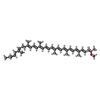+Search query
-Structure paper
| Title | Cryo-EM Structure of the Light-Harvesting 2 Complex at 2.1 Å. |
|---|---|
| Journal, issue, pages | Biochemistry, Vol. 60, Issue 44, Page 3302-3314, Year 2021 |
| Publish date | Nov 9, 2021 |
 Authors Authors | Pu Qian / David J K Swainsbury / Tristan I Croll / Pablo Castro-Hartmann / Giorgio Divitini / Kasim Sader / C Neil Hunter /   |
| PubMed Abstract | Light-harvesting 2 (LH2) antenna complexes augment the collection of solar energy in many phototrophic bacteria. Despite its frequent role as a model for such complexes, there has been no three- ...Light-harvesting 2 (LH2) antenna complexes augment the collection of solar energy in many phototrophic bacteria. Despite its frequent role as a model for such complexes, there has been no three-dimensional (3D) structure available for the LH2 from the purple phototroph . We used cryo-electron microscopy (cryo-EM) to determine the 2.1 Å resolution structure of this LH2 antenna, which is a cylindrical assembly of nine αβ heterodimer subunits, each of which binds three bacteriochlorophyll (BChl) molecules and one carotenoid. The high resolution of this structure reveals all of the interpigment and pigment-protein interactions that promote the assembly and energy-transfer properties of this complex. Near the cytoplasmic face of the complex there is a ring of nine BChls, which absorb maximally at 800 nm and are designated as B800; each B800 is coordinated by the N-terminal carboxymethionine of LH2-α, part of a network of interactions with nearby residues on both LH2-α and LH2-β and with the carotenoid. Nine carotenoids, which are spheroidene in the strain we analyzed, snake through the complex, traversing the membrane and interacting with a ring of 18 BChls situated toward the periplasmic side of the complex. Hydrogen bonds with C-terminal aromatic residues modify the absorption of these pigments, which are red-shifted to 850 nm. Overlaps between the macrocycles of the B850 BChls ensure rapid transfer of excitation energy around this ring of pigments, which act as the donors of energy to neighboring LH2 and reaction center light-harvesting 1 (RC-LH1) complexes. |
 External links External links |  Biochemistry / Biochemistry /  PubMed:34699186 / PubMed:34699186 /  PubMed Central PubMed Central |
| Methods | EM (single particle) |
| Resolution | 2.1 Å |
| Structure data | EMDB-13307, PDB-7pbw: |
| Chemicals |  ChemComp-BCL:  ChemComp-7OT:  ChemComp-LDA:  ChemComp-CA:  ChemComp-HOH: |
| Source |
|
 Keywords Keywords |  PHOTOSYNTHESIS / PHOTOSYNTHESIS /  Purple bacteria / Purple bacteria /  Light harvesting complex 2 / LH2 / Light harvesting complex 2 / LH2 /  Membrane protein / Membrane protein /  Cryo-EM. Cryo-EM. |
 Movie
Movie Controller
Controller Structure viewers
Structure viewers About Yorodumi Papers
About Yorodumi Papers





 cereibacter sphaeroides 2.4.1 (bacteria)
cereibacter sphaeroides 2.4.1 (bacteria)